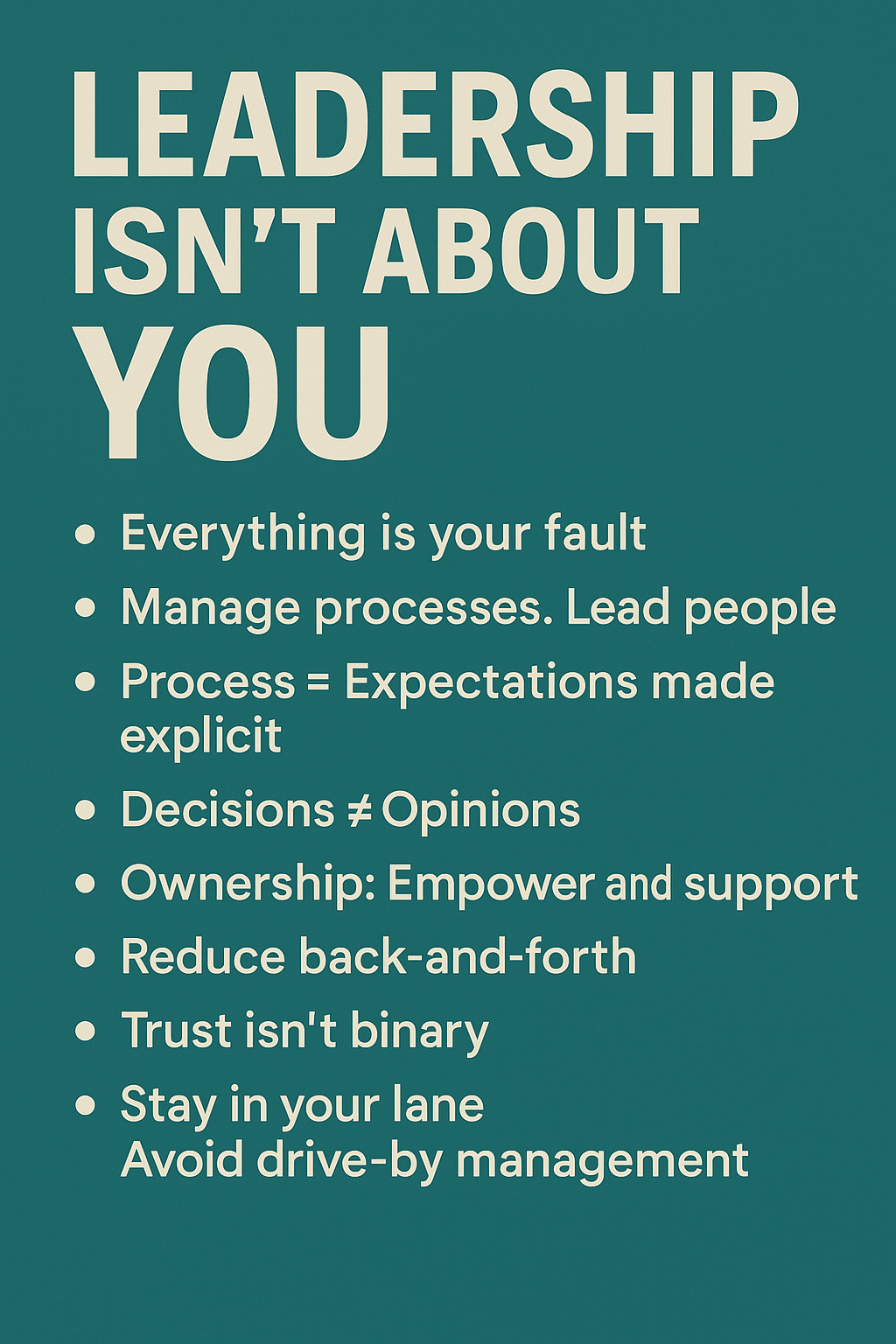Most of us didn’t wake up one day and say, “I want to be a manager because I love meetings and owning everyone’s mistakes.” But if you’re in a leadership role, whether you’ve been doing it for decades or you’re just getting your sea legs, you’ve hopefully already figured out: it’s not about control. It’s about ownership, trust, and building the right environment for your team to thrive.
If you haven’t learned that lesson yet, that’s ok – here’s a break down some of the most important leadership lessons that many of us (myself included) learned the hard way.
💥 Rule #1: Everything Is Your Fault
Seriously. All of it.
- The outcome? You’re responsible.
- The person? You hired them (or chose not to let them go).
- The process? You designed it—or didn’t improve it.
You’ve got more information than your team. More influence. More context. That means you’re accountable. Getting mad at your team? It’s a waste of energy and leadership capital.
🔄 Manage Processes. Lead People.
Please stop trying to “manage people.” That’s a surefire way to:
- Burn them out.
- Drive away your best talent.
- End up micromanaging every detail.
What you should manage:
- Processes. Clear expectations, roles, responsibilities, and ways of working.
- Boundaries. What people own, where they can grow, how they can raise concerns.
What you should lead:
- Humans. With empathy, clarity, and consistency.
📜 Process = Expectations Made Explicit
Processes aren’t bureaucratic nightmares. They’re just clarity, written down.
Good process:
- Doesn’t slow people down.
- Helps unblock others.
- Is simple, consistent, and explicit.
“Every morning, we do X to make sure everyone else is unblocked” — that’s a process.
🧠 Decisions vs Opinions
One of the most important distinctions you can make as a leader:
- Who makes the decision?
- Who is contributing input (aka opinions)?
Everyone can share thoughts, but decisions should rest with the person closest to the work. That includes when you outrank them. Unless it’s a true emergency (cue the emergency handbrake metaphor), let them drive. Then, support or debrief.
🧭 Ownership: The Long Game
You want people to own problems and run with them. That’s the dream.
- If they mess up? Help them learn.
- If they’re not the right fit? Help them move on.
- If you constantly swoop in? They’ll stop caring.
Ownership means trusting people with the work, not just to do the work.
🗣️ Kill the Ping-Pong
Back-and-forth feedback loops kill momentum.
If you give someone feedback, trust them to handle it or tell you why they won’t. Don’t hover waiting for updates or approvals. Set the bar, then let go.
🔍 Trust: It’s Not Binary
Trust isn’t an on/off switch. It’s:
- Contextual (you trust different people in different ways).
- Earned over time.
- Lost quickly.
- Maintained with effort.
Build systems of trust. Set expectations for new teammates. Don’t assume trust just “exists.”
🧾 Transparency Builds Trust
Want your team to trust your leadership?
- Make your work visible.
- Share decisions and thinking freely.
- Put things where people can find them without asking.
Most folks won’t ask. Doesn’t mean they don’t care—just that they don’t want to bother you.
🧠 Decision Layering: Stay in Your Lane
Just because you can jump into someone else’s work doesn’t mean you should. Cross-functional work depends on mutual clarity and boundaries.
Let others do their job. Don’t “drive-by manage” just because their project seems more fun this week.
🗨️ Drive-By Management = Chaos
When you lob feedback, opinions, or mandates into a meeting with no context or follow-through? That’s chaos.
Your voice carries more weight than you think. Don’t casually throw out ideas unless you clarify:
- It’s an opinion, not a decision.
- It’s not an action unless we make it one.
🔊 Explicit > Implicit
In every meeting:
- Who owns this?
- What was decided?
- If nothing was decided—say that explicitly too.
Unspoken expectations are where chaos lives.
🧯Burnout Isn’t About Workload
Burnout doesn’t always come from working too hard. It often comes from:
- Lack of control.
- Lack of clarity.
- Lack of purpose.
Want to prevent burnout?
- Give people control over their impact.
- Protect them from unnecessary chaos.
- Help them see their value.
😵💫 Chaos Hits Harder at the Bottom
Remember: you probably knew about the pivot two weeks before the team did. You may even have had input on it.
They didn’t.
The closer someone is to the ground level, the more surprising and disruptive change can feel. Have empathy for that gap.
🪞Expect More from Managers
If you lead managers, your expectations should rise:
- When something goes wrong? It’s on them, not their team.
- Success? That belongs to their team, not them.
- Their job? Make space, not take credit.
And above all: Give them your trust and honest feedback in return.
Final Thought
Leadership isn’t about being the smartest, loudest, or most decisive person in the room. It’s about building systems that let smart, capable humans do their best work—and caring enough to stay human while doing it.
Lead with clarity. Act with humility. Trust like it matters—because it absolutely does.
Want to chat about leadership challenges or swap scars? Hit me up. We’re all learning as we go.




